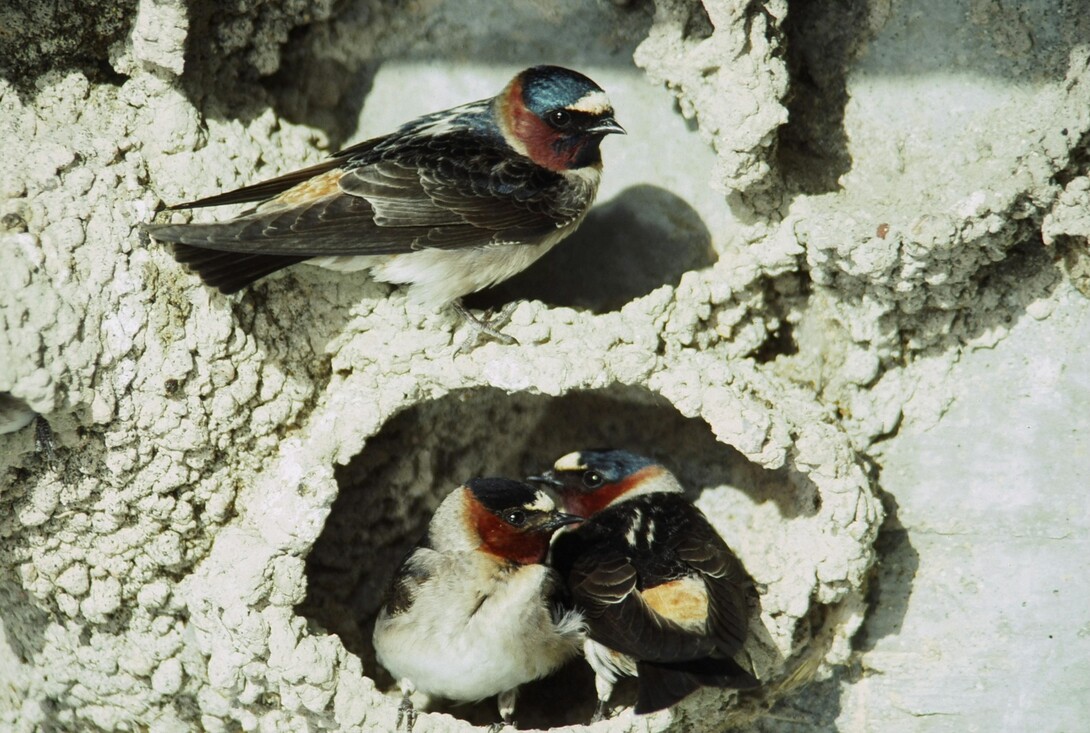
April 4, 2013
LINCOLN, Neb. — It's not the wind beneath their wings but rather the SUVs there that have inspired cliff swallows to take flight in their recent evolution.
A 30-year study by the University of Nebraska-Lincoln's Mary Bomberger Brown and colleagues found that cliff swallows in southwest Nebraska have adjusted to the dangers of cars around their habitat by developing shorter wing lengths, a fact that makes them less likely to become road kill.
The study was outlined in a recent article in Current Biology by Brown and co-author Charles R. Brown of the University of Tulsa in Tulsa, Okla.
Cliff swallows often nest under bridges and overpasses, which makes them susceptible to being killed by passing cars. Bomberger Brown's research shows that such road kills have decreased over the past 30 years, as the birds' wing lengths have shortened.
"Evolution is an ongoing process," said Bomberger Brown, a research assistant professor in UNL's School of Natural Resources. "Things like roads and SUVs have all become part of nature or 'the wild'; they exert selection pressures in ways we don't usually think about."
Bomberger Brown's study, one of the longest continuous evolutionary studies ever, focuses on a highly social bird species.
"We started watching swallows at about the same time as they discovered bridges," Bomberger Brown said. "It was like catching them at the discovery of the wheel."
Initially interested in the social behaviors of the cliff swallow, Bomberger Brown's research developed into a broader study of the species.
"We began by banding the birds to track them," she said. "Every year, we'd go back to check on them. When we saw a road kill, we'd pull over to see if it was one of our birds." Even if it wasn't, the researchers collected data about the birds' physical characteristics. It was this data that developed into the findings announced in Current Biology.
Bomberger Brown and Brown noticed that the birds found on the side of the road disproportionately possessed longer wings, a quality that made the birds less aerodynamic compared with their shorter-winged counterparts.
"It's like the difference between a U2 spy plane and a fighter jet," Bomberger Brown said. "Shorter wings make for easier mobility," which allows birds to fly upward and pivot away from oncoming traffic.
The researchers were able to eliminate other potential causes for the results, noting especially that bird populations increased even as road kills decreased. Additionally, studying the types of automobiles on the road – specifically the increase in SUVs, with their higher front-end surface area – they found that the decrease in mortality could not likely be linked to the types of vehicles on the road. The most likely cause – and statistically significant correlation – appeared to be wing lengths.
"It's a lesson in how to collect data," said Bomberger Brown. "We didn't set out to study this question, but we collected as much data as possible. In the end, the data told us what we should notice."
The research also benefited from fortuitous historical moments. In 1996, about mid-way through the study, a prolonged period of rain and snow in the area prevented the birds from feeding for several days in a row. Swallows carry enough fat reserves on their bodies to sustain them for about four days. By the fifth day, about half the birds starved to death.
"It was a bad day," said Bomberger Brown. "But it was a fast burst of evolutionary change. We could study the qualities of the birds who died and the qualities of the birds who survived."
The findings from that experience only further solidified the trend already visible in the data: birds with short wings, sturdy bodies and symmetrical physiques could navigate and move with more efficiency. Those that possessed longer, more air-resistant wings and fragile or asymmetrical frames suffered the most from the prolonged bad weather. The trend that the road kill data showed – specifically regarding the detriments of long wings – overlapped with the fast-burst evolutionary change.
"We were able to keep track of the group of birds who survived for 10 more years. They consistently did better among the population demographics."
The results are significant among scientists interested in animal adaptation, especially with regard to human-nature interactions. The fact that cars placed natural selection pressure on the birds meant that birds with better-equipped physiques could adapt to their surroundings.
Bomberger Brown said these birds now face increasing selection pressures to adapt to a changing climate, a phenomenon that scientists consistently link to human activity.
"We have already seen how weather extremes affect the birds," Bomberger Brown said. "Our data shows that our cars have had an effect on birds. Now we'll see what the climate we've created will do."
Perhaps that is where Bomberger Brown's studies will go next. When asked, she smiled and replied she's not sure. "The birds will tell us what's next."
To read Bomberger Brown's findings, check out Current Biology's article, found at http://www.cell.com/current-biology/fulltext/S0960-9822(13)00194-2.
Mary Bomberger Brown, Ph.D.Research Assistant Professor
School of Natural Resources
402-472-8878
mbrown9@unl.edu Michelle Hubele Rubin
Communications Specialist
School of Natural Resources
402-472-8021
mrubin2@unl.edu Dan Moser
IANR News Service
402-472-3030
dmoser3@unl.edu







